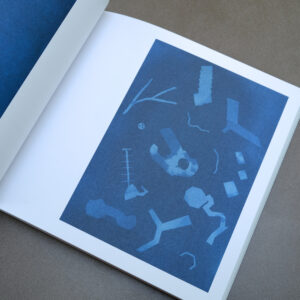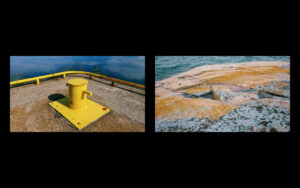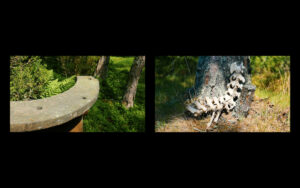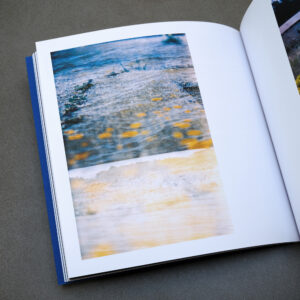Rob St. John’s new book, film, and seven-inch single from Blackford Hill document a multi-year residency project on the tiny Finnish island of Örö, during which he translated meticulous field research into sound, image, film, and poetry. Greg Thomas reviews.

Rob. St John’s new multi-format release centres on a series of evocative sonic renderings of the overlapping human and animal worlds of Örö, a tiny island in the Finnish peninsula previously used as a military base. Nails are bowed like violin strings in a disused barracks, the sound coupled with the crunch of footprints in snow and the clang of hydrophones dropped through sub-arctic ice. A raven cackles at midnight. Rock strata from the sea-bed around the islet are encoded in sound as pitch shifts on a brushed bell. Summer algae blooms and seasonal temperature changes become flurries of harp notes.
During 2016-17, Lancashire-born composer and artist St. John spent two residency periods on Örö, experiencing the vastly different climatic and atmospheric conditions of midwinter and midsummer. One of several creative practitioners invited to take part in the Öres residency programme, he initially presented work from this project as part of a group exhibition last year, combining the musical aspects just outlined with a video-work made up of short, paired visual sequences presenting different island terrain at different times of year.
St. John has frequently turned to littoral landscapes and aquatic ecologies in his practice, including compositions mapping the waterways of Edinburgh and London. But the little world of Örö presented possibilities for a more deeply layered project. Approached by label Blackford Hill to develop his film into a more widely available format, St. John proposed the idea of a book mapping the fieldwork towards the video, to be presented alongside a seven-inch vinyl comprising elements of the film soundtrack worked up into short-format pieces through additional instrumentation. The resultant collection of goodies, together with a digital link to the 2022 film, is the bundle under review.
The landscapes of Örö presented a series of go-to creative options that St. John was keen to think around, describing the multi-format work titled Örö as “neither elegy nor exercise in ruin lust.” He is perhaps alluding here to the moody or gothic imagery that might have been invited by the island’s historic use as a military base. It was established as such by the Russian Empire in 1915, just two years before Finnish independence was declared. The 3×2-km site, at the southern end of a scattering of islands stretching out into the Gulf of Finland west of Helsinki, was then taken over by the liberated country’s armed forces, who occupied it until 2016. Brutalist battlements still scar the shoreline, though Örö is now part of a national park, and a fledgling tourist industry offers hiking trails, boat trips, and camping spots.


The contested islets of the historically shifting Russian-Finnish border might seem a newly urgent topic, given Vladimir Putin’s invasion of Ukraine and disconcerting rhetoric on the historic reaches of the Russian empire. But St. John homes in on the more slowly unfolding catastrophe of climate change, using a series of creative translations or transliterations into image and sound to track processes such as nutrient pollution in the bay and changes in geological strata caused by aquatic oxygen deficiencies and nuclear fallout. At the same time, the visual and sonic documents of Örö evoke a brief window of time between the island’s past as an armoured fortress and its likely future as a family fun-spot during which flora and fauna could live and grow relatively undisturbed.
Both film and book are split, chronologically speaking, into seven sections: Exposing, Framing, Patterning, Surfacing, Weathering, Diffracting, (De)Composing, Emerging. Each reflects a different mode – or cluster of modes – of engagement with the island to gather raw materials and data, and is accompanied by a written outline of methods and a spiralling pattern-poem. The ‘Weathering’ section of the film, for example, incorporates the sound of rain, wind, and debris falling on piano wire strung between military structures on the island’s south-west spur. The ‘Framing’ section of the book includes the results of various experiments in cameraless photography, as described in St. John’s accompanying mini-essay:
‘One set of experiments used organic winter island materials – lichens, dried seed pods, bird feathers, reeds, sands and sediments – to create 35mm film photograms. In the dark of the cabin bathroom, 35mm canisters were cracked and unfurled – like the unrolling of the ecologist’s transect line or the archivist’s microfilm reel – and weighted at each end with stone. Relying only on touch in the pitch black, the island materials were laid out on the film strip and exposed in a brief flash of headtorch light: a visual patterning akin to being in the forest at night.’
The ingenuity and layered aesthetic resonances of both the creative method and its description here give a hint of the depth and scale of work that underpins Örö.
St. John’s new release is a complex and multifaceted entity, but the artist’s introduction to his book gestures towards an overarching motif, describing ‘an attempt to develop more-than-human modes of creative enquiry and practice…attentive to the island’s complex natures.’ One thing that ties together the visual, sonic and poetic effluences of Örö is an interest in symbolically foregoing the human senses to render an encounter with non-human life and processes, in an environment where these are unfolding in intricate, myriad ways intimately connected to human activity and and history. The description could apply, of course, to many natural environments, but the bounded quality of the island location, and the particular resonances of its cultural history, perhaps allowed these to be framed and relayed with particular clarity and piquancy. A work that rewards deep and contemplative encounter.

*
‘Örö’ is out now and available here.
Greg Thomas is a writer and editor based in Glasgow. His writing appears in Art Monthly, ArtForum, Burlington Contemporary, Scottish Art News, and elsewhere. Visit his website here, or follow him on Twitter / Instagram.